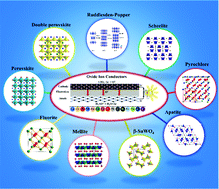Rare earth elements based oxide ion conductors
Abstract
Rare-earth elements (REs) based oxide ion conductors show promising performance and potential applications in solid oxide fuel cells (SOFCs). To meet the requirements of intermediate-temperature (IT) SOFCs operating in the range of 600–800 °C, oxide ion conductors with various structures were developed and summarized here, namely, pure oxide ion conductors and mixed oxide ionic and electronic conductors (MIECs). For the former, their structures range from traditional structure types (perovskite, fluorite, etc.) to new structures with isolated polyhedral units. For MIECs, perovskite and related structures have dominated this field due to their high oxide ion and electronic conductivities. Among these oxide ion conductors, REs play a crucial role in the modification of the structure and performances due to their unique characters, such as lanthanide contraction effect and stable valence (+3). This review emphasizes the structure–performance relationships among the REs. Furthermore, challenges particularly towards obtaining high oxide ion conductivity at low temperatures for lowering the operating temperature and thereby enhancing the device performance, and future prospects of RE-based oxide ion conductors are also discussed, together with advanced research techniques and new research directions being the possible strategies to overcome these challenges.

- This article is part of the themed collections: 2021 Inorganic Chemistry Frontiers Review-type Articles, Rare Earth Chemistry – In memory of Professor Xu Guangxian at his centenary and Celebrating 110th Anniversary of Chemistry at Peking University


 Please wait while we load your content...
Please wait while we load your content...